Flagstone Patterns
Browse paving patterns for flagstone patios, paths, driveways & more By Maureen Gilmer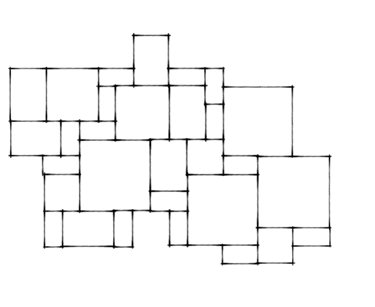
Use a random rectangle pattern for traditional or formal landscapes.
This pattern is made up of precisely cut stones of various sizes. The stones are arranged so that the joints jog around rather than continuing in a straight line for long distances. The rectangular shape of the flagstones used in this pattern lends an organized feeling to the design, while the staggered joints break up the monotony. This pattern looks nice around a rectangular swimming pool, on a more formal dining terrace or as a straight path leading to the main entrance of a home.
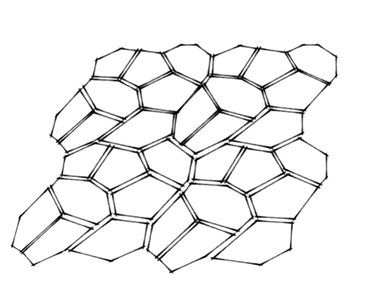
Use a random cut stone pattern for paving that is casual, yet controlled.
This pattern has a more natural appearance than stones that are cut into squares or rectangles, yet each piece still fits together precisely. Although each stone has a random shape, the edges have been cut, making it possible to get tight, consistent joints. Furthermore, all the flags in this type of pattern are approximately the same size. Flagstones can be purchased precut for this type of pattern, or your mason can cut them on site. There are even flagstone mats available, where multiple stones are linked together on a mesh backing, that make installation quick.
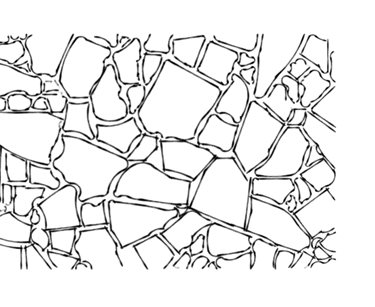
Use an irregular pattern of small stones to create an organic appearance.
This flagstone pattern, sometimes called crazy paving, is all about using the natural shape of the stone. Cutting the stones is avoided as much as possible. The contractor will work to find pieces of stone with shapes that fit together nicely without altering. The process can be compared to putting together a puzzle. The rough edges of the stone make it so the joints vary in width. Small stones are used for filling in gaps between the larger flags. For this pattern the size of the stones is less important than the shape. Because of the rough edges and complex network of joints, this pattern may be difficult to move patio furniture around on.

Use large irregular slabs to create paving with fewer joints.
If you like the organic look of the irregular or crazy paving, but are concerned about the busyness of all the joints, consider using oversized flagstones or slabs. This pattern takes large pieces of stone and fits them together as best as possible. This may be a better choice for outdoor living spaces where patio furniture will need to be moved around. Mortared and dry laid installations are both possible with this pattern.
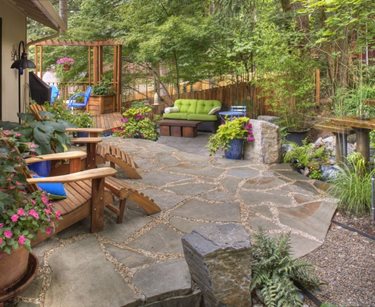
Use a random pattern in a casual setting.
Often called random or crazy paving, this flagstone pattern appears casual and natural. Irregular flags are laid in a fashion that creates an asymmetrical patchwork of stone. A mason carefully arranges the pieces as if he were putting together a puzzle, letting the shape of each stone dictate its placement. This patio has an array of small, medium and large stones dispersed evenly. You may request that all your stones be approximately the same size if you’d like a more precise and uniform appearance.
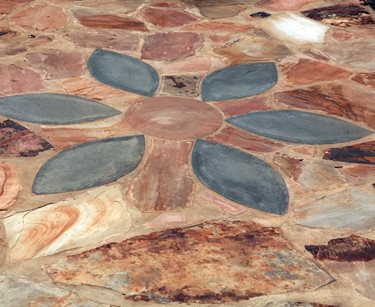
Accent units integrated into flagstone paving help to organize space by their location, size and degree of contrast.
It takes a skilled mason to create patterns in a flagstone patio such as this simple floral motif created with hand cut slate "petals". Laying flagstone requires highly experienced contractors to set a level surface with irregular stone that may vary a little or a lot in its thickness. Accents such as this are a good way to transform a flagstone patio into a more visually interesting paving, or when this central point makes sense due to the presence of other elements at the edges.
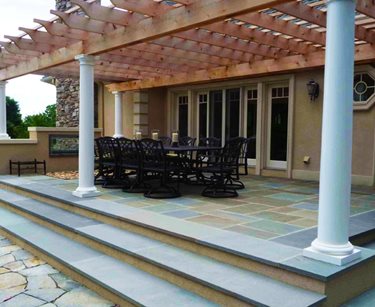
Create a hierarchy of spaces by selecting flagstone that is also available as thin milled veneer.
When you find a material that adapts equally well to natural flagstone paving as it does milled units, there's an opportunity to create a hierarchy of spaces. The finely milled stone tile on the dining terrace is elegant and finished with equally precise steps. These flow down to the more casual patchwork of flags that are integrated by color despite its very different character. The irregular shapes imply a more relaxed space than the formal one above, and sends a subliminal message to visitors who subconsciously recognize the difference.

 Backyards
Backyards
 Front Yards
Front Yards


